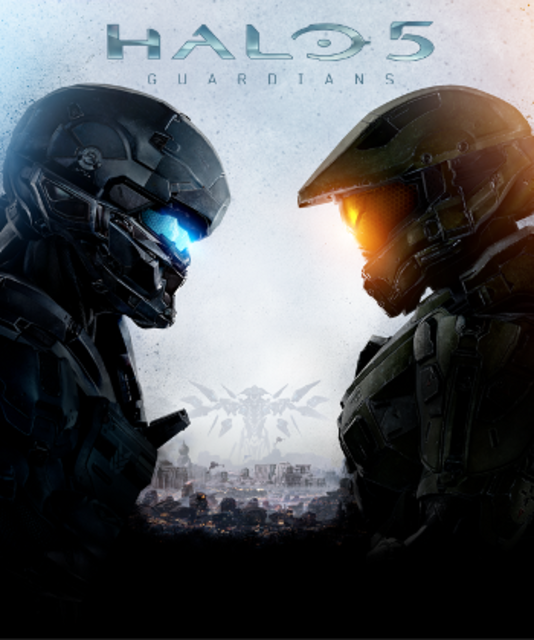Age of Conversion
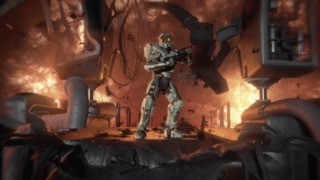
Back in 2012 Halo fans experienced a rather nerve-wracking run-up to the release of Halo 4. The mantle had been passed from Bungie Studios to 343 Industries and the burning question was whether 343 could successfully recreate the ubiquitous features and mechanics of the series that we’d come to know inside out. The worries weren’t just over a beloved franchise being placed into new hands, they were also to do with who 343 are specifically. This is a company that was new on the scene at the time and was essentially formed by a huge tech corporation who controlled the Halo IP and needed a way to continue it. There was a voice at the back of people's heads that questioned whether 343 could truly be a creative force with the series or whether they were there to make cold, factory line iterations on the franchise formula. The company had success in 2011 with Halo: Combat Evolved Anniversary, but that was a fresh coat of paint on an existing game, Halo 4 was the first new game they were building from the ground up. To the great relief of everyone following the series 343 managed to deliver, giving us an exhilarating, polished new Halo with the distinctive feel of the series still tangibly present. In retrospect though I wish more of us had held Halo 4 to a loftier goal. With a new studio taking the baton, there was an opportunity to reinvent the series and for 343 to put their own unique mark on it. It was an opportunity that was for the most part missed.
There were new mechanics in Halo 4 for sure, but most of what it introduced were ideas in the vein of killstreak rewards, perks, and custom loadouts. These are mechanics from the Call of Duty school of game design. There’s nothing wrong with Call of Duty, but it both works against the distinction of that series and the diversity of the shooter space in general when people crib large armfuls of mechanics from it over and over, as we've been experiencing for many years. 343 conducted some adaptation of these mechanics to fit the Halo style, but it was a bit disappointing to see them contributing to the homogenisation of AAA shooters and giving up a chance to do something more original. I suspected this approach to design represented the future of Halo: a line of games that were going to be in themselves great but too scared to ever really push the boat out. That means for me Halo 5: Guardians comes as a pleasant surprise. After about half a decade with their hands on the series it feels like 343 have not just executed on everything that makes people want to play a Halo game, they’ve at last put their own personal touch on it.
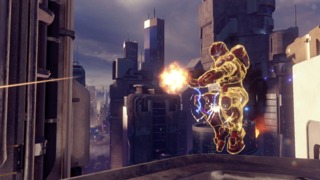
One of the first things you notice about Halo 5 is just how different the weapons handle. Aiming is looser, but in most cases not so loose as to be uncomfortable. This is balanced out by all guns now having iron sights and in multiplayer mode by Spartans going down faster than before. In turn, your lower shield capacity is compensated for by a meter that shows how long until your shields will recharge again, allowing for more precise management of them. This makes headshots harder and makes it a bit more difficult to turn a scrap around when you get hit first, but it allows for accuracy to be better rewarded and it pushes the game to move at a faster pace without becoming a twitch shooter. I’m someone who could get consistent headshots in Halo 4 but find myself having to learn that skill anew with 5. I know that won’t be everyone’s bag, but I find that refreshing.
The bump up in required accuracy means that automatic weapons like the Assault Rifle are as viable as they were back in Halo: Combat Evolved. This is appropriate because gone are the ordinance and loadout systems of the last two Halos, you’re back to spawning with default weapons (usually the Assault Rifle and Pistol) and picking up whatever else you might need from the environment. In previous Halo multiplayer modes this had meant an inconsistency between the power players wielded in the game and the effort they put in to gain that power. Rocket Launchers, Energy Swords, and other hyper-destructive tools were often awarded to whoever happened to stumble across them or simply be the fastest person to run to them at the start of a match. This may still be true to an extent, but now power weapons are clearly marked on the map and the countdown to new ones respawning is loudly displayed to all players. It makes nabbing a high damage weapon more likely to be the result of a successful fight or good map control than luck or rotely plodding the same routes of the map over and over. Battle Rifles and DMRs can also be picked up from the ground with greater frequency meaning that staple precision weapons still get a fair look-in.
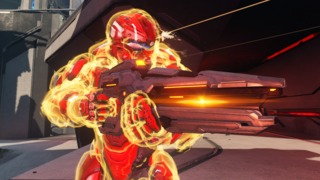
There are some new weapons on top of these, but the more important changes to Halo’s arsenal are in the alterations to existing guns. Halo 4 had a problem with its Forerunner weaponry. The Forerunner are meant to be alien in the truest sense: not just a species from an entirely different place and time than humanity, but a highly advanced civilisation with unusual and unrecognisable tech. Despite that their guns all seemed like tweaks of human or Covenant weapons. The Suppressor was an Assault Rifle with a faster rate of fire and wider bloom, the Boltshot was a cross between a Plasma Pistol and a Shotgun, etc. It didn’t help that the series had already performed this trick this back in Halo 2 where Covenant equivalents of UNSC weapons were introduced. This time around however, 343 haven’t been afraid to completely rework their old weapons and in 5 it feels like the Forerunner guns better belong to themselves.
In practical terms the Scattershot still serves as little more than a Shotgun with a cool disintegration effect, but the Suppressor has a rate of fire that starts slow and speeds up, the Boltshot is now a three-shot homing pistol, and so on. New animations, scopes, and sound effects work in tandem with this fresh weapon behaviour to build towards a total impression of truly original combat tools. It’s also great to see the Pulse Grenade revamped, not because it was derivative like the other weapons mentioned here, but because it had limited and specific utility. The Pulse Grenade could help you control space but always felt a bit limp. It simply didn’t have the same sting as the Frag or Plasma Grenades. Now however, it creates a wall of orbs damaging anyone who runs into them. Quieter and potentially a one-hit kill with a deft throw, it feels like a serious part of the game the same way the other two grenades are. Changes in how you can move and attack also go beyond the weapons you’re carrying.
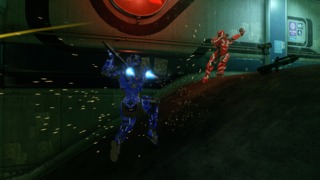
Running through environments is never a chore because you now have unlimited sprint, and the capacity to clamber up ledges makes for fewer of those annoying moments where you’d jump for a platform and just smack against it. Everyone is equipped with a boost activated with the B button, giving you more agency in how you dodge attacks beyond just stepping or jumping out of the path of danger. The moments when you manage to rocket behind a wall just as the last of your shield ebbs away come with a palpable sense of relief. In terms of attack, you can now perform the Spartan Charge which is activated by hitting RB while sprinting, propelling you into your enemy and knocking them backwards as well as dealing damage. It lets the game subvert that awkwardness from 4 and Reach where you’d be constantly clicking in and out of sprint for fear you’d stumble on an enemy around a corner and not immediately be able to strike. In an almost superhero-like fashion you can now hover for a limited time as you fire your weapon, able to make vantage points over foes wherever you like at the risk of become a more conspicuous target for them. If you are so inclined you can also take that hover into a Ground Pound, dealing costly damage to anyone in your landing zone but like the Spartan Charge, leaving you inactive for a second afterwards. The Spartan Charge and the Ground Pound have wonderful impact behind them and overall it feels like these changes really open up the melee and movement systems for Halo. Moreover, the environments you use all these weapons and moves in look great.
Often the trade-off for having high graphical fidelity in a AAA game is an art style that is more drab than what you might see from the independent scene, but Halo 5 does what the series does best, existing at the intersection of inspired sci-fi art and tremendous technical prowess. Both up close in the face of intricately designed enemies and from far away, staring out at the game’s sweeping, fantastical vistas, this Halo is simply gorgeous. It’s another game of vivid colour and well-codified design for the places, people, and technologies of each in-game faction. It makes me wish you could more easily take screenshots without a Kinect or that Theatre mode could be still used in Campaign because Halo 5 is one of those games where you’re constantly seeing opportunities to capture beautiful moments. Special praise has long been given for the picturesque skyboxes of the series, but Halo 5 goes one better, filling out areas external to the map with their own scenery models. It probably says something that I once died in a match because I was distracted by how captivating the outside alien fauna was.
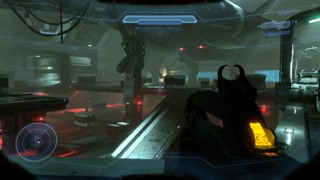
In Campaign play spaces are also now busier, both with enemies and geometry, meaning that battlegrounds can feel less open than in previous games, but a multitude of enemies, cover, and paths through fight spaces make the game feel rich in terms of your available tactical approaches, and battles just feel bigger. One thing that gives you a sense of a persistent war in a game like this is not just there being many enemies, but there being conflict on the battlefield outside of your influence. When you can arrive in a warzone and find Covenant fighting Prometheans you feel like you’re joining an actual battle as opposed to just encountering a group of enemies sitting around, waiting for you to show up. It’s something that 343 lean into more than ever here and it’s a wonderful little touch.
Another big aesthetic bump for the game is that the sound has more punch than before and from gunfire booming through service buildings to the curious noises of alien installations it’s a delight to listen to. In addition, audio is more of a part of the UI than ever and gives the impression you’re fighting alongside human characters. Other Spartans will now tell you about the weapons they’ve picked up or warn you about enemies and it’s genuinely useful. You may also note that the game’s music is under different stewardship this time around. Kazuma Jinnouchi who provided additional music for Halo 4 and has previously worked on the audio for various Metal Gear games replaces Neil Davidge as the primary composer. He gives us a more energetic soundtrack that dips back into the original Halo theme here and there. It’s a blend of old and new that better matches 343’s sensibilities with the games and I wish it got a more prominent place in the audio mix. There’s powerful music in here and yet it feels like 343 bring it to the forefront of the game less often than Bungie did. But that’s aesthetics, let’s look at narrative.
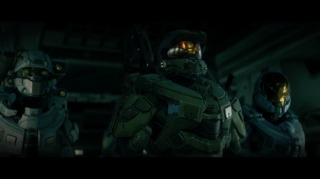
The perspective of the story is divided between two groups of characters. There’s Blue Team, consisting of the Master Chief and three other Spartan-IIs he grew up with, and there’s Fireteam Osiris, the shiny new Spartan-IV squad led by the tenacious but level-headed Locke. While Blue Team have gone AWOL, tracking down Cortana so that the Chief may bring her home, Locke’s team are hunting them down to turn them in to the proper authorities. It makes sense: Without Cortana chirping away inside his head the Master Chief is given the only other combat ready allies he has to provide dialogue and exposition, and having a team of old characters and a team of new characters allows 343 to please long time fans while forging their own new branch of Halo lore. There’s also now a more canonical justification for a co-op mode that doesn’t leave two players as stock marines.
On just about every level Halo 5 is about upping the scale: more enemies, larger stages, bigger setpieces, and that works everywhere else, but here it feels like Halo 5 bites off far more than it can chew. The game has eight player characters in addition to other important participants in the story like Halsey, Cortana, and the crew of the UNSC ship Infinity; it’s trying to introduce big new concepts and places and by its end set up some highly transformative events for its world; it’s a game that’s trying to lock with the fates of three alien different civilisations in an eight hour runtime (at least on Normal difficulty). It collapses under an enlarged ambition for what it wants to do with its story but a lack of any larger space to tell that story in. Its predecessor had similarly struggled with how to express a lot of what it wanted to express about the history of its world and that manifested in an uncomfortable glut of lore dumped halfway through the game, but 343 now have far more they want to touch on and their solution is to double down on outsourcing much of the interesting storytelling to other facets of the franchise.
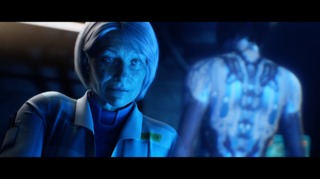
In Halo 5 most of both Blue Team and Osiris are barely recognised as people, they’re just thrown in as vessels through which things can be shot, meanwhile the story talks about Guardians, Jul 'Mdama, and Sangheili out of the gate as if you’ll know what all these things are. I do appreciate that more in Halo 5 is done to tie the game back into the books and that it doesn’t waste time explaining what you might already know from other expeditions into the universe. At the same time, if you haven’t explored Halo’s expanded universe you can still follow the story from beginning to end, but it often feels as though there’s important context for the things you see and hear that’s just beyond the scope of what the game is willing to cover, and Halo 5 lacks the time to explain and invest you in large portions of its backstory. Feeling like you’re experiencing a fully-formed narrative here involves first going on a scavenger hunt down various Halo media rabbit holes.
If you want to be invested in Blue Team and understand where Halsey figures into the plot then you need to have read Halo: Fall of Reach, if not also the other early Halo novels. If you want to be familiar with Spartan Locke then you need to have played the Master Chief Collection even if you’ve already played through the original trilogy, and you may also want watch live-action series Halo: Nightfall. To be familiar with Buck you need to play through a six year old spin-off of the main Halo series in the form of Halo 3: ODST, while the Spartan-IVs as a concept are introduced in the novel Halo: New Blood. To be informed about many of the story threads that connect Halo 4 and 5 then you need to have seen all of the cutscenes in Halo 4’s rather lackluster Spartan Ops mode and read the graphic novel series Halo: Escalation which also introduces Spartan Tanaka. Spartan Vale on the other hand is introduced in the novel Halo: Hunters in the Dark. One of the few areas where Halo 5 lets up on this is that unlike in Halo 4 the Forerunner trilogy of novels aren’t so supportive to the story, which is surprising because you’d think that’s where the Guardians must be from. As it turns out they’re not properly introduced anywhere in Halo’s mediaverse.
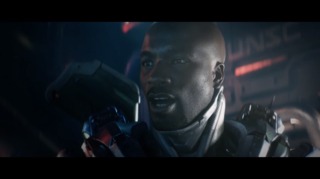
Halo 5 feels stuck between trying to present a self-contained narrative and trying to hook that narrative into the meta-fiction of the series in a way that feels like it matters. The experience is often propped up by surrounding film and literature rather than just incorporating it and anyone who actually has an investment in that film and literature is likely to find that Halo 5 doesn’t do justice to the characters from it. It’s hard not to respect the game for its inclusion of a black protagonist in the form of Locke or making half its playable Spartans women, but Halo 5 is very selective about both who it cares about and when it cares about them. Characters exist far too often as just another avatar in the world.
As for what Halo 5 manages to add to the series itself, it’s a game of two halves in more ways than it may intend. Almost by design everything that advances the plot and could make dramatic changes to the world is experienced through Master Chief and co. because they’re the ones venturing ahead into parts unknown, while Locke and his team play catch-up. Halo 5 follows the usual pattern of humans exploring an ancient Forerunner world to find some terrible and grand secret of the universe, and one of the antagonists it sets up feels a little too much like a pantomime villain, kitted out with a very similar personality to the Didact from Halo 4. Given that the Halo 4 ending made it look like Cortana had truly kicked the bucket I’m also still not a huge fan of the series now telling us she’s very much alive, but that’s not a plot point Halo 5 invented, it merely pursues it, and the nature of what’s happened to Cortana breathes new life into her character. They even fix the “Cortana is always naked” weirdness. What’s more, by the time the game reaches its end it feels like it sets up a whole new conflict for the universe that comes from a thoughtful and fascinating place, and has more interesting implications in its potential outcome than one side just winning or losing a war. In fact it would have been good if a little more exploration of this struggle was in Halo 5 itself and not pushed out to reside in Halo 6.
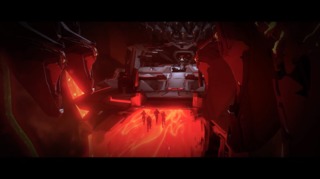
Osiris, considering their position, do however make some decent discoveries of their own. Further into the game as the gap closes between them and Blue Team it feels like they’re only retreading the same locations and concepts Blue Team have, but their journey is greatly helped by the fact that they don’t take a direct beeline to the Master Chief. Instead to retrieve those last active Spartan-IIs they take a zig-zagging path that leads them through such locations as a human outpost that has a bone to pick with the UNSC and a planet in the raging centre of a civil war. The game even has three very short missions where there is no combat, just the opportunity to hang around these locations and listen or speak to characters. It deserves to work out better than it does because these are the kind of diversions that can truly give a world character. However, the mechanics to interact with characters in more than the crudest way aren’t there and most of the people you run into in the non-combat missions are background players whose dialogue fails to give meaningful insight into them. I wish you could dive better into what the cultural and historical states of these worlds are, but they’re satisfying to visit none the less.
The game also tries to bind the characters more tightly together through mechanics. The ally AI has had a contentious history in the Halo games, but I’d argue that the problem has never been as much that the programming behind your teammates has been bad as it has been that you’ve often been forced to rely on that programming or had their poor performance shoved in your face. In the original Halo trilogy it was never particularly a problem that your allies couldn’t approach a skirmish as remotely intelligently as you, but when you needed them to drive you somewhere or operate the turret on a Warthog that’s when the groaning started. In Halo 5 your brothers and sisters in arms feel like they come down perfectly in between being token soldiers on the battlefield and taking your job as the player from you. Player One can direct the team to attack enemies or rally to a point, bringing a sense of more organised co-operation to your squad, but the ally AI interact poorly with one of the big new campaign mechanics.
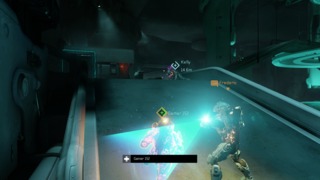
Running out of health no longer pushes you back to the last checkpoint, instead downed characters can be revived if their allies can stand stationary near them for a few seconds. Like any revive mechanic it provides a new way to feel like you’re more directly helping and being helped by your comrades, which is great in co-op and sometimes single-player, it’s just ally AI are really bad at using it. In any situation when you are knocked down and need to get back on your feet the AI is dumb enough to stand directly in the line of fire of enemies while trying to get you up. When facing powerful foes or when facing an abundance of enemies on the higher difficulties it’s not uncommon to see them form a kind of “Down and need assistance” conga line. There’s one particular boss that the game likes to reuse that feels like it was made for co-operative play but the ally AI aren’t intelligent enough to understand the strategy needed to beat it. The boss is meant to be hit from the back and is capable of deploying one-hit kill attacks, and you repeatedly pay the price for your AI’s ineptitude in taking it on, especially when it comes to the way computer characters try to revive people. It’s excruciating to experience and helps breed contempt for the characters. Then there are the changes to the multiplayer structure.
While Halo had gotten to the point where it was offering a cornucopia of game types, Halo 5 essentially whittles the experience down to five: Slayer, Capture the Flag, Breakout, Strongholds, and Warzone. These are currently spread out across five different playlists, running from Team Arena down to SWAT. The exclusion of classic gametypes like Oddball and Flood feels like an arbitrary decision that helps to limit the variety of the multiplayer, although the absence of King of the Hill is mostly made up for by another mode I’ll discuss in a second. There is however no splitscreen mutliplayer, so no more sitting around on a couch with your friends popping off headshots, and at the time of this writing the game is also missing its Forge map editor, a feature that’s been key for community expression in the past, although judging by a blog post from 343 it’s on its way. As for the new gametypes, let’s take a look.
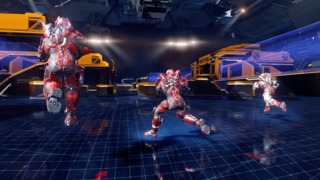
Breakout is a 4-on-4 mode where players have no shield and one life each. Rounds are won by eliminating the entire opposing team or by scoring the flag on the map. The first team to win five rounds wins the match. The combination of no shield and a single life can make this a tense experience as members of each side are hunted down one by one. This mix of Slayer and CTF also potentially provides a shakeup in the way you achieve victory. The downside is that it turns Halo into another twitch shooter, it’s been rare for me to see anyone engage with the CTF component, and I’m still not a fan of game modes where you have to sit out while the match continues on without you.
Strongholds is a 4-on-4 mode reminiscent of Territories and King of the Hill from previous games. Both teams are tasked with capturing and holding hill-like locations on the map to score points. Where this structurally differs from Territories is that a team can only earn victory points while controlling the majority of the capture points on the map. It’s a formula that generates constant action. A team that is way ahead can’t just hang back and rely on the points from a single territory until the end of the game, they still need to actively fight and work out how to distribute their players to maintain that second capture point, and the opposing team making a comeback is a far greater possibility at any time. I like this twist on the traditional “Capture the points” mode a lot.
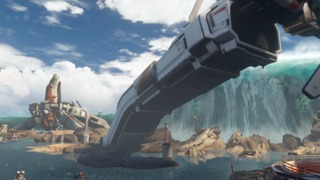
Warzone is a 12-on-12 mode that combines elements of Dominion and Big Team Battle from previous games along with influences from other popular competitive titles. It’s like a Halo-flavoured mix of Battlefield, Titanfall, and a MOBA, but less confused than that might sound. Victory is awarded to whichever team can first reach 1,000 points or destroy the “core” in the opposing team’s base. Points can be earned by holding capture spots and by defeating AI enemies (especially bosses) on the map. It feels like an effort to bring that sense of large, open conflicts from the campaign mode over to the multiplayer and it achieves that. Not just because of the map size, the big vehicles, or the literal number of participants, as thrilling as those things are, but also because again, the game goes big with the number of strategic options available to you at any one time. When things go well a team collectively has to keep track of a lot to stop their score slipping and when things go badly there are still often multiple alternative routes to winning so you aren’t just waiting for the clock to run down so you can start another match.
That widescale conflict isn’t something you always get to participate in however. Sometimes you just need people to hold down a point even if they’re only there as backup or the point isn’t under immediate threat. This mode can come down to just sitting around a base while the fighting happens elsewhere. Then there's the real rain on this parade: the “Req System”. As matches progress you have the opportunity to call in steadily more powerful weapons and vehicles, in theory letting these face-offs build to a crescendo of destruction, but calling in that help requires you to burn “Requisition Cards” which are earned external to Warzone matches themselves. You get packs of these cards when you level up or when you complete Commendations, but you can also buy them with in-game currency or real currency. Certainly the latter this is the only way to reliably get the most powerful items or to unlock any aesthetic alterations for your character.
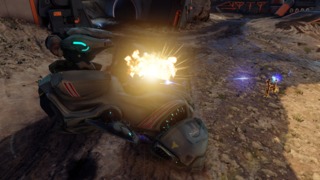
It’s odd because it flows against the design philosophy behind the rest of the multiplayer. Halo 5 makes a radical and refreshing decision that few shooter games do these days: It strips out loadouts, ordinance, perks, and armour abilities to make what happens in matches have nothing to do with progression systems or what menu options you’ve picked, and instead matches play out like they do purely because of the actions players make within them. Warzone flies in the face of that and in Warzone the decisions you make about what weapons and vehicles to deploy often have little to do with strategy and more to do with boring bookkeeping of how much of what you have in your inventory. Then there’s the frustration of opposing players literally being able to pay their way into picking up power weapons and vehicles to wield against you. I didn’t expect Halo of all games to succumb to the dreadful trend of arbitrary microtransactions in £40/$60 games. It’s not just bad, it feels insulting. I’m seeing a lot of people say they’re going to solve this problem by just leaving Warzone alone, but the issue doesn’t exist in isolation. Big Team Battle is another one of those things that’s apparently coming to the game, but as I’m writing this Warzone is still the only mode that has vehicles, and there’s a remarkable sense of loss in not being able to drive the Ghost or Warthog in Slayer or play Capture the Flag the same way you used to on Blood Gulch or Valhalla.
There are also problems with how players are pitted against each other. While Halo has almost always had some way of trying to match people of similar skill levels together, Halo 5 makes a particular point of trying to refine the system. Every season, each of the game’s playlists have you play ten placement matches and based on your level of skill it then sorts you into one of seven rank brackets where you will purportedly be squared up against players of roughly the same bracket. You can advance your rank in each of these brackets by consistently winning matches and if you’re good enough eventually rise into the next bracket. The mechanics of both the Req and the ranking system are actually things I had to look up online as the game itself makes almost no effort to explain them. Halo 5 has these odd situations where the information you need is scribbled on some webpage somewhere instead of anywhere in the actual executable. Unlike the Req system the ranks are a great idea on paper, at least at the most basic level. It’s not just an attempt to make sure that players are fairly matched against each other, but also makes the systems used to line up players more transparent. It’s easier to understand how your rank changes now and you have some tangible marker of your skill rating in the game instead of it being a number hidden away on Halo Waypoint or in the background of a network server.
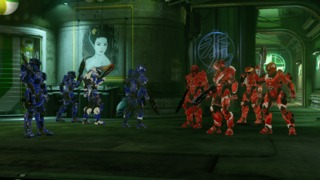
In practise however, if you want to be properly ranked for all playlists that means playing an insane fifty matches every season before the game’s provisions to make sure you’re fairly matched even kick in, and I’ve found the variation in opponent difficulty doesn’t calm down after completing my placement matches. This inconsistency stacks with other parts of Halo’s big matchmaking machine to create larger headaches. Using wins and losses instead of K/D or other stats to rate you is intended to make your rank about how well you can work as part of a team instead of just as an individual, but in this way the game holds you as a single player entirely responsible for the success or failure of your team, which is not reasonable. Games where players perform well but the rest of their team don’t match up or where they perform poorly but the rest of their team carry them happen all the time. It doesn’t help that Halo 5 feels like a big step backwards in the way it deals with people quitting out.
343 have introduced harsher penalties than ever for players who betray, idle, quit, or generally ruin other people's games, which is great in itself, but it’s a system of internal conflict. Bad matching encourages you and other players to leave matches prematurely, but the game threatens you with a matchmaking ban for the same behaviour it encourages. Of course, players inevitably do quit anyway and when it happens the game makes no attempt to replace them. I don’t mean that there’s a system to fill empty gaps in your team roster that doesn’t work, I mean by design the game leaves those gaps unfilled. I’ve played plenty of matches where one side was able to dominate the other because of lopsided team numbers the game refused to fix.
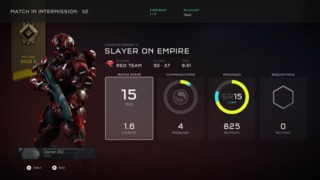
343 seem more intent than ever in trying to ensure that factors like server connections and player behaviour don’t interfere with your time online, perhaps spurred on by the matchmaking disasters of the Master Chief Collection, but in the end it’s not network infrastructure or people being people that does the damage to the online experience as much as the design and implementation of the systems 343 are using to try to mitigate problems in the first place. This is the kind of game that can place you with scatterbrained allies against formidable opponents or let half your team drop out with no remedy, have you suffer through an imbalanced match, and then at the end punish you as though it was your fault. The multiplayer also suffers from other odd problems here and there, like some commendations being far too easy to max out or player clans only having a capacity of 100 players which feels crazy for a AAA game published in 2015.
Of all the Halo games, Halo 5: Guardians feels of the least consistent quality. While it has some fantastic gameplay, visuals, and music, the framework and context into which it places that content often feels as though it has integral bits missing. There’s an overcrowded story, silly ally AI, fewer ways to play than even Halo 3 had, a gross microtransaction system, and a multiplayer that’s sometimes openly unfair. However, not only does Halo 5 once again unleash almost everything that made previous games so special, but its commitment to reinventing itself and broadening the potential strategic choices for players makes it feel like 343 have a voice in it, and that it is in no danger of being swallowed up into the larger tropes of modern shooters. If Halo 4 was 343 Industries working out how to make a Halo game then Halo 5 is them taking those lessons and working out how to make their Halo game. It’s an FPS where from the moment I began I was shocked by just how different it all felt, and in a good way. While other developers would consider their own additions to a series set in stone, in Halo 5 343 show that they’re not afraid to completely tear up their old mechanics if it’s in the interests of making a more fun and original experience, and this is both a fun and original experience.
